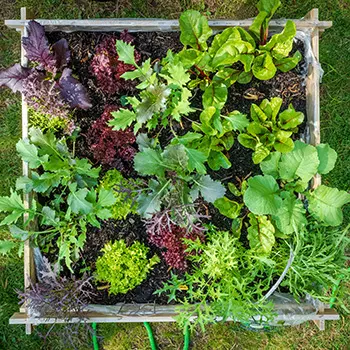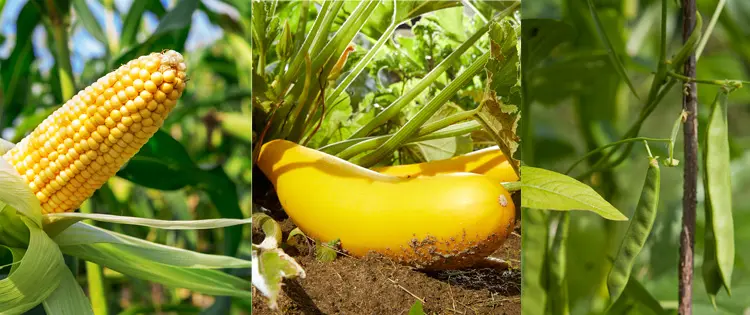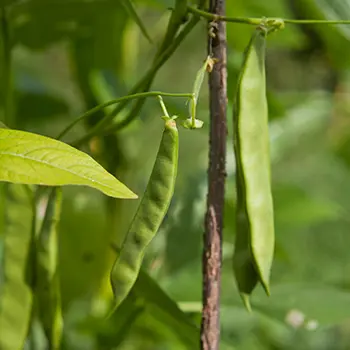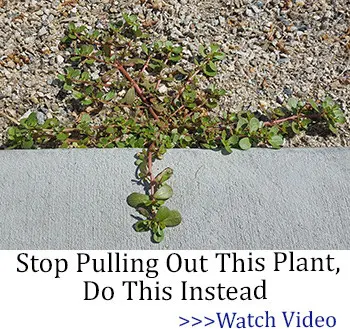These three sisters planting gardens kept Native Americans of several different communities alive for thousands of years.
Easily planted together, corn, beans, and squash work off of one another to create a new life and wonderfully easy-to-grow plants that will keep your tummy full.
Let’s dive right in.
Who Are The Three Sisters And Why Plant Them?
The three sisters planting plan refers to corn, squash, and beans. For hundreds of years these were the foundation of culinary traditions and agriculture for Native Americans.
Why plant them? Balance! Everything in the natural world comes back to balance.
- Corn – Offers the foundation needed by beans to climb while not being out-competed by the squash vines.
- Beans – Offer soil fertilization as they are nitrogen-fixers. This means that they take nitrogen from the air and then convert it into forms that are easily absorbed by the roots of other plants.
- Squash – Features large leaves that give the shade needed by the ground to effectively retain soil moisture. This also helps with preventing the appearance of weeds.
These three plants are rarely predated upon by the same insects. In fact, most squash bugs hate the smell of growing corn and beans.
Like true siblings, the Three Sisters have grown together for eternity because they work well together. Even better than that, they grow easily together and encourage beginners to try something other than upside-down tomato plants and tiny herb gardens. Growing these foundation plants of our civilization is usually an encouraging gateway for more complex gardening down the road.
Three Sisters Planting: What You’ll Need
I’ll be assuming that you’re using a raised bed in this case. If you don’t have one, most of the advice given in this article will be easy enough to translate into in-ground planting (or, well, some of you are wild enough to use containers for this; more power to you!). Just a heads up that when I say raised bed, I’m talking about any and all planting areas.
Personally, I recommend a raised bed for three sisters planting so you can give the corn a little extra nitrogen without having to turn over and till old plots, hoping for the best. A fresh raised bed allows for better management.
In any case, you’ll need a good corn seed. I like Silver Queen corn, personally, but choose a good sweet corn seed since you’re likely not drying this. For the beans, pole beans work well—I often use Rattlesnake beans. And for squash, pick any variety with large leaves that can effectively shade the roots of the other two Sisters, a key part of successful three sisters planting.
General gardening soil and typical fertilizer are enough for these plants. You can’t easily scorch them, but don’t go overboard with fertilizer.
Timing Is Everything
To begin your three sisters planting, start by sowing your corn just after the last frost. Once the corn grows to about 6–8 inches tall and the root bulb is sturdy, you can plant a few bean seeds around it.
If you’re using nursery plants instead of seeds, wait until the corn is about a foot tall before adding the beans. As the beans grow and send out runners—usually within a week—gently guide them to climb the corn stalks. This way, they’ll use the corn as a natural bean pole instead of tangling with the squash.
A week after the beans start sending out runners, plant your squash. Once the squash develops its first true leaves, maintenance becomes simple. You’ll only need to water and fertilize the base of all three plants occasionally. The exact frequency will depend on your soil’s drainage and your local weather conditions.
Three Sisters Planting: How You’ll Mess It Up Your First Year
And now we get into how you’ll mess it up. You’ll overwater. Expect it. You’ll likely over-fertilize, too. Try to keep in mind that the corn is using the nitrogen from the beans to grow and you really don’t need to pour the ground full of nitrogen for that nitrogen-hungry corn to eat up.
You may also accidentally grab a fertilizer that’s great for squash but not fantastic for beans. These are rare and are typically high in sulfur. They’ll make your beans tangier than they need to be. Skip it. Use a general fertilizer that’s good for your area and your soil for vegetables.
How You’ll Do Better Next Year
You’ll find three sisters planting easier to manage after your first year, even if it feels confusing at first. If you’ve gardened before, you’ll likely adapt quickly. It’s rare to lose an entire Three Sisters garden unless you face major insect infestations, severe storms, or just plain bad luck.
Even better, this method will inspire you to keep trying. Once you see the beans climbing the corn stalks and the squash shading the soil, the purpose of each step will click. No book or video can compare to getting your hands dirty and learning through experience.
The Other Sisters
In other cultures, we see other crops used in traditional agriculture. As an example, for the indigenous cultures present in the Southwest, tobacco is just as sacred as the 3 sisters.
Amaranth and sunflowers are often referred to as “the other sisters”. They offer the much needed shade to other plants during afternoon heat, can provide more stalks for the beans to climb, and effectively attract pollinators.
Amaranth greens and edible sunflower seeds give you extra foods for a more balanced nutritive diet.
If you do not want to plant squash as one of the 3 sisters, you can always go for cucurbits like gourds and watermelon. The growing habitat is very similar and their sprawling vines will offer shade in a similar way to what the squash does.
True Generational Gardening
If staggered correctly, most of your product will come into season at about the same time. It is rather neat to look at all the different growth times of these particular plants.
That said, don’t be too surprised if your corn begins to wilt and your beans are still producing. Don’t be shocked if your Jack-O-Lantern pumpkins are round and orange and your corn isn’t quite ready for harvest yet. Things can be thrown off a little when you’re a beginner, but you’ll get the hang of it very soon.
Anything else you’d like to know about the Three Sisters? Post a comment down below or send us a message. We always love to talk about this long-lived, traditional way to grow these centerpiece foods that keep the world from being hungry. As always, Happy Gardening!
You may also like:
If You See This Plant in Your Backyard, Burn It Immediately! (Video)
11 Fast Growing Vegetables To Grow In A Crisis












